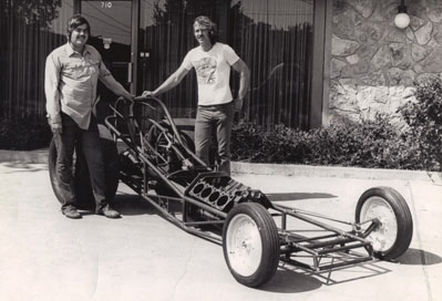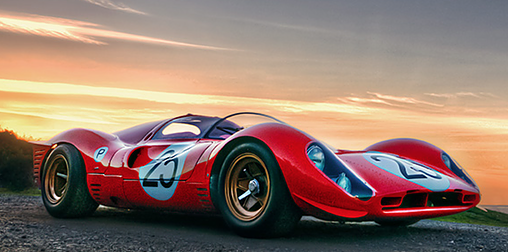
“Jim Jackson and Bob Norwood with the low-riding Flyer chassis. Bob has gone on to field exotic cars at Bonneville and Jim has set some records” -NHRA
The Man, The Myth, The Legend, Bob Norwood, has been building, racing, restoring and servicing vintage/race Ferraris and other vehicles for over fifty years. He’s known for incorporating innovative developments into high-performance automotive design.
Norwood’s passion for automobiles started at a young age. At 13, he drove a 1946 Ford Coupe in his first competitive drag race. He continued drag racing while in high school, driving a six cylinder GMC G-Gas Coupe and later an A-Sports Corvette. In 1971, he raced a Superstock Hemi-Cuda and made it number two in the world A/FC point standings.
Norwood got into Cam AM racing in 1982 with the purchase of the 1979 Citi-Corp Championship car from Carl Hass. He ran SCCA A-Sports with driver Phil Compton and continued on in 1983 with the addition of a second Lola 333 driven by Mike Rowe. The Norwood team partnered with Don Walker in late 1983, bought Team VDS and won Cam AM in 1984. At one point Norwood was the proud owner of 137 listings in the Guinness Book of Automotive World Records.
In the mid ‘80s, Bob’s modified Ferrari 308 QV, the first with programmable fuel injection, set two class speed records on the Bonneville Salt Flats and one of them stood for 26 years.
His Ferrari 288 GTO rebody still holds the record as the fastest Ferrari in the world and his intercooled twin turbo Ferrari Testarossa won a Road & Track Magazine Shootout.
In the late ‘80s, Norwood equipped a Ferrari 12-cylinder Boxer engine with a locomotive sourced supercharger. It featured a lightened flywheel and knife-edged crank and could rev from the engine’s 1200 RPM idle to the 9,000 RPM redline in just over a tenth of a second. It was certified on a Superflow 901 engine dyno to make 1,400 horsepower on 120-octane gasoline at 60 psi boost.
The short-stroke 3.2-inch bore engine was upgraded with a billet Crower crankshaft, extra-long Crower rods and custom forged pistons. It was managed by a Haltech F3 EFI controller and a Firepower Direct-Fire 12 coil ignition system. fastforward to today and Norwood is making (including the engine block and heads) custom 5.0 liter 4 cylinder engines from scratch that produce 3,000+ horsepower!
Drawing on his racing background and passion for Ferraris, Norwood’s first Ferrari restoration projects were a 330 2+2 road car and a Boano club racer. He then built his first Ferrari replica, a 59/TR (Testarossa), and went on to build four more. He has since built numerous Ferrari replicas, including the 330/P4. After years of building P4 replicas, GTO rebodies, and 250 Testrossa 59s, Norwood decided to build rebodied Ferrari 250 GT SWB Spyders (scroll down to learn more about these and his 330 P/4s).
In addition to his own projects, Norwood builds race and street motors for several racing teams and is one of the leading service and restoration providers for Ferrari owners/collectors around the world.
Few Ferrari collectors can afford the $10 million plus price for an original Ferrari California 250 GT Spyder, but Bob Norwood is building the next best thing, perfect rebodies at a fraction of the price.
Although Norwood used 250 chassis for the TR 59 replicas he previously built, they’re almost impossible to find now. On the other hand, 330 chassis, with all the correct mechanicals to build a GT 250 California, were more readily available and affordable when Norwood decided to start producing 250 rebodies. His worldwide search generated 9 330 chassis.
Currently in production, the GT 250 California Spyder lives again. The chassis is shortened from the 2+2 configuration to SWB Ferrari length and, using three-l digital scanning technology, is rebodied in alloy to the same dimensions as the original Ferrari California GT 250 Spyder. Each of the cars in this ultra limited production run retains the original 330 serial number and is a real Ferrari, not a replica.
Experience the thrill of driving the GT 250 California Spyder, a high performance collector sports car priced to be on the road, rather than in a museum!
Dimensions and weight
Overall length: 4201.16 mm – 165.4 in
Overall width: 1719.58 mm – 67.7 in
Height: 1369.06 mm – 53.9 in
Wheelbase: 2400.3 mm – 94.5 in
Front track: 1371.6 mm – 54 in
Rear track: 1374.14 mm – 54.1 in
Curb weight: 830 kg. – 2315 lbs in
Body Construction Material
Hand formed alloy
Chassis Construction Material
Separate Tubular Steel chassis with steel two-seat, two-door convertible body
Wheels
Wide Borrani wire wheels with knockoff spinners
Brakes
Dunlop disc (front and rear)
Paint Color
Customer Preference
Engine
No. of cylinders: V12
Construction: Alloy block and heads
Valve gear: Two valves per cylinder operated by a single, chain-driven overhead camshaft and rockers
Bore and stroke: 2.87 in. x 2.31 in.
Displacement: 2953 cc
Compression ratio: 9:2:1
Maximum power: 280 bhp at 7,000 rpm
Maximum torque: 203 lbs-ft at 5,000 rpm
Super Spyder Engine Option (Sourced from 575M)
No. of cylinders 65° V12 F
Bore & stroke 89×77 mm 3.46 x 2.95 IN
Unit displacement 479 cc 29.2 cu. in.
Total displacement 5,748 cc 350.7 cu. in.
Compression ratio 11:1
Maximum power 379 kW (610 bhp) at 7,250 rpm
Maximum torque 588,6 Nm (60 kgm) 580 ft.lbt at 5,250 rpm
Performance
Maximum speed 150 mph
0-60 mph 7.0 sec. (around 4.5 sec. with Super Spyder Engine)
Transmission
Four-speed manual
Pricing
Three have been completed, sold and delivered to happy owners. Six remain. They’re built to order and take six to twelve months to complete.
$935,000 – $985,000 (varies based on option configurations)
Ever seen a $50,000,000 car? That’s what the only remaining 1967 Ferrari P4 is estimated to be worth. SEE and learn more about it by watching this short video:
Check out the articles below to learn as much as you’d like about the Norwood P4.

Dimensions and weight
Overall length: 4320.79 mm – 170.110 in
Overall width: 1810 mm – 71.5 in
Height: 1000 mm – 39.37 in
Wheelbase: 2450.79 mm – 101.98 in
Front track: 1488 mm – 63.58 in
Rear track: 1450 mm – 62.08 in
Curb weight: 860 kg. – 1895 lbs in
Fuel capacity: 28 Gallons in
Body Construction Material
Body – Hand Formeed Aluminum
Frame Construction Material
4130 Tubular Steel
Fuel Tank
Stainless Steel
Tires
Front – 10.15 x 15 Dunlop
Rear – 12.15 x 15 Dunlop
Wheels
Technomagnisia
Brakes
Front – 12 in. Willwood 4 piston
Rear – 12 in. Willwood 4 piston
Paint Color
Customer Preference
Engine
No. of cylinders: 65 V12F
Bore & stroke: 89×77 mm 3.46 x 2.95 IN
Unit displacement: 479 cc 29.2 cu. in.
Total displacement: 5,748 cc 350.7 cu. in.
Compression ratio: 11:1
Maximum power: 379 kW (610 bhp) at 7,250 rpm
Maximum torque: 588,6 Nm (60 kgm) 580 ft.lbt at 5,250 rpm
Paint Color
Engine selection and validation is paramount in the build process for the P4 by Norwood. A rigorous inspection program that involves pulling the intake manifold and valve covers to inspect every component of the top-end valvetrain – valves, valves springs, cams, etc. On the bottom end the oil pan is removed to inspect the lower sections of the block, the main bearings and rod bearings. Any pieces not in compliance with factory Ferrari specifications are removed and replaced with factory Ferrari parts. In addition to the painstakingly detailed inspection, all assembly hardware is re-electroplated, removing any doubt the donor engine is in impeccable condition before getting acquainted with its new home.
While the oil pan is off, the team makes some minor modifications to better align the large V12 in the P4 mid-engined chassis. The stock oil filter housings are machined off to prevent any potential clearance issues. To complete the modification new fittings are added in the oil pan to allow remote mounting of the oil filter. The modification also goes beyond safety as the lower center of gravity adds to the already impressive handling.
Performance
Maximum speed
0-60 mph 4.0 sec.
0-80 mph 6.0 sec.
1/4 mile 125 MPH
3/4 mile 170 MPH
Transmission
5 speed synchro limited slip
Final drive ratio – 3.44,9″
Only 30 Norwood P4s will be produced. 15 have been completed and sold. They’re built to order. As a result, you can pick your color combo. Production time is approximately 12 months. Grab one of the remaining 15 today!
Price: $925,000